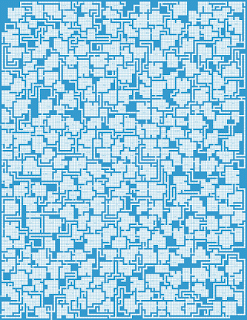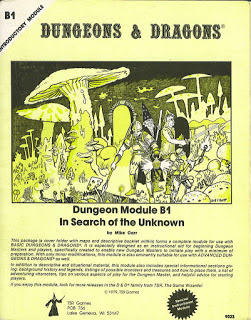 |
| It’s big, but is it mega? |
There’s been a lot of chatter in my own little corner of the OSR web lately about megadungeons, and this is a thing that I both enjoy and encourage. For obvious reasons, I’ve got quite a few opinions about the megadungeon concept and execution, and I’m not afraid to share.
But I think in order to properly frame the discussion, we need to get a bit of definition around what, exactly, a megadungeon is.
Quite a few people subscribe to the “mythic underworld” interpretation of the megadungeon, where it represents a place where the normal rules of the world no longer apply, and wherein fantastical and abnormal things can be encountered. Indeed, Philotomy’s Musings (a well-traveled booklet in certain circles) gives a length discourse on the megadungeon as mythic underworld, and in addition provides the following criteria for the mythic underworld/megadungeon (which he significantly uses interchangeably):
- It’s big, and has many levels; in fact, it may be endless
- It follows its own ecological and physical rules
- It is not static; the inhabitants and even the layout may grow or change over time
- It is not linear; there are many possible paths and interconnections
- There are many ways to move up and down through the levels.
- Its purpose is mysterious or shrouded in legend
- It’s inimical to those exploring it
- Deeper or farther levels are more dangerous
- It’s a (the?) central feature of the campaign
Personally, I’m not a fan of the mythic underworld interpretation, if for no other reason that in what has become the default style of FRPG campaign, there really is no distinction between the laws of reality in the dungeon, as compared to the town or inn. In a Campbellian sense, there’s no definitive transition between the normal world and the world of fairy tales wherein one can encounter orcs, and vampires, and find magic rings. You could very well be attacked by a vampire while staying in your (supposedly) safe space.
Now, certainly, this is not the only approach to setting up a FRPG campaign, and something like the Western Marches campaign (seriously, if you’ve not read that yet, go do so immediately; it’s brilliant) does in fact make the distinction. The town is safe, the lands to the west of the town are not. But when compared to “most” FRPG campaigns, that’s the exception.
But more to the point, it fails to distinguish between a “regular” dungeon (one that can be “finished” in one or more sessions and play) and a megadungeon. For instance, I would argue that Philotomy’s criteria 1, 4, 5, 6, 7, 8, and 9 could apply to all sorts of different adventures and not just a megadungeon. I would also argue that 2 doesn’t even necessarily apply to a megadungeon, although it could (and I would argue could apply to certain sorts of adventures, such as extra-planar excursions, more than it does to a megadungeon).
For instance, let’s take one of my favorite modules, B1: In Search of the Unknown.
Certainly, it’s big, and has many levels. It’s not linear (although Dyson Logos made an effort to make it moreso); has several interconnections between levels; is certainly shrouded in legend as a general thing, even though its purpose is pretty straightforward (to act as a base for Zelligar and Rohgan); and it’s definitely inimical to explorers (what dungeon isn’t?). While it doesn’t necessarily get harder as one goes from the surface, the second level certainly seems to be more deadly than the first, and 9 is not relevant because it can be plugged into any campaign (by design) and could certainly serve as a campaign tentpole (I used it in just such a way once, and it was a great success).
But I don’t think anyone would argue it is a megadungeon.
What does that leave us? Simple.
3. It is not static; the inhabitants and even the layout may grow or change over time
That, to me, is the key. That’s what makes something a megadungeon, rather than a regular dungeon. Any tomb or fortress or magic vault can be deadly, or get harder as you go further from the entrance, or whatever else.
But what makes a megadungeon special is that it is literally impossible to “clear”.
Part of this is because of its size. You might be able to clear out a level (indeed, some of the PCs in the original Greyhawk campaign did just that, for a while, and claimed it for their own), but you’ll never clear the dungeon. It’s just not possible. Because while you’re off exploring level 8, the orcs on level 3 are tunneling into a side level, and the myconids in that cavern in level 7 are spawning new warriors, and the Mad Archmage at the bottom is busy forming gates to new demi-planes.
Speaking of which, Wayne at Initiative One is entirely right. A megadungeon doesn’t have a “boss” that can be defeated. If that were the case, doing so would “clear” the dungeon, which is exactly what can’t be done to megadungeon. Certainly, individual levels can have bosses. Absolutely! But even Zagyg at level 13 of Castle Greyhawk, and the Mad Archmage at the bottom of Castle of the Mad Archmage, aren’t bosses in that sense. They’re not there to be defeated. They’re there to open up yet another aspect of play. Certainly, meeting them can be viewed as a victory of sorts, but when you take the slide to China, you haven’t defeated the dungeon. You just have farther to walk to go back to exploring it. Because the Greyhawk Construction Company just opened up a new side level on level 4 that wasn’t there the last time.
In fact, we can infer exactly this from the racial abilities built into 1E. Detecting new construction makes absolutely no sense in a game sense unless there’s new construction to detect.
So where does this leave us? It’s not size (although size is important from a practical standpoint). It’s not deadliness, because any dungeon worth its salt is deadly. It’s all about replayability. The state of being wherein the PCs could, if they wished, keep going back into the dungeon over and over and over and over, and never, ever, not have something new to explore. (They might not find it, but that doesn’t mean it’s not there.) And that isn’t limited to physical construction, either; demi-planes and other extra-dimensional gates, time portals, cursed scrolls taking PCs to the Starship Warden; they all count as part of the megadungeon.
Without that element of infinite replayability, you don’t have a megadungeon. You just have a large dungeon, which is a very different thing.











How did you make the blue and white dungeon floorplan picture?
Visit https://donjon.bin.sh/d20/dungeon/ and pick "colossal" dungeon size, hit "construct" and switch the map style to "classic" should give you something to work with?